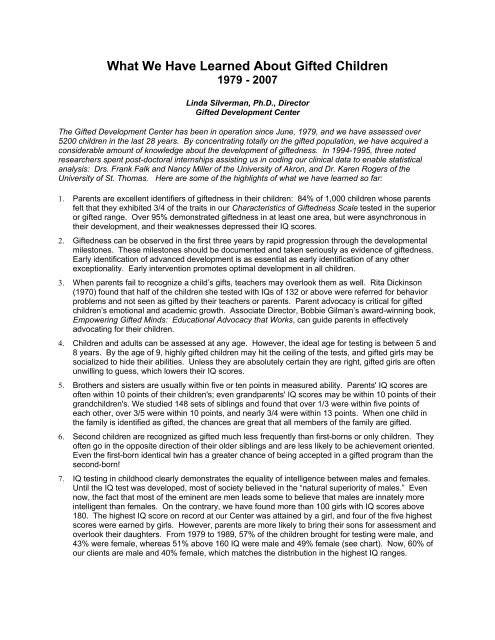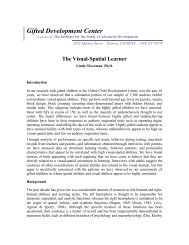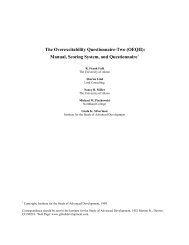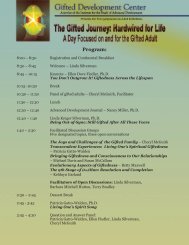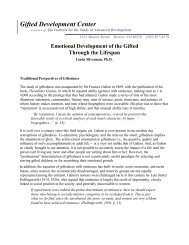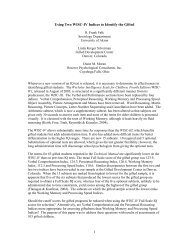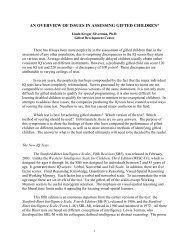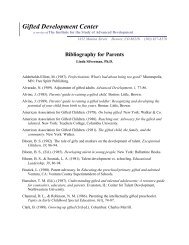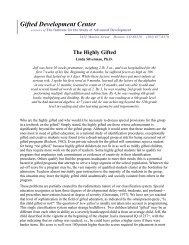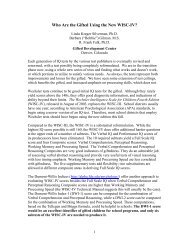What We Have Learned About Gifted Children - the Gifted ...
What We Have Learned About Gifted Children - the Gifted ...
What We Have Learned About Gifted Children - the Gifted ...
You also want an ePaper? Increase the reach of your titles
YUMPU automatically turns print PDFs into web optimized ePapers that Google loves.
<strong>What</strong> <strong>We</strong> <strong>Have</strong> <strong>Learned</strong> <strong>About</strong> <strong>Gifted</strong> <strong>Children</strong><br />
1979 - 2007<br />
Linda Silverman, Ph.D., Director<br />
<strong>Gifted</strong> Development Center<br />
The <strong>Gifted</strong> Development Center has been in operation since June, 1979, and we have assessed over<br />
5200 children in <strong>the</strong> last 28 years. By concentrating totally on <strong>the</strong> gifted population, we have acquired a<br />
considerable amount of knowledge about <strong>the</strong> development of giftedness. In 1994-1995, three noted<br />
researchers spent post-doctoral internships assisting us in coding our clinical data to enable statistical<br />
analysis: Drs. Frank Falk and Nancy Miller of <strong>the</strong> University of Akron, and Dr. Karen Rogers of <strong>the</strong><br />
University of St. Thomas. Here are some of <strong>the</strong> highlights of what we have learned so far:<br />
1. Parents are excellent identifiers of giftedness in <strong>the</strong>ir children: 84% of 1,000 children whose parents<br />
felt that <strong>the</strong>y exhibited 3/4 of <strong>the</strong> traits in our Characteristics of <strong>Gifted</strong>ness Scale tested in <strong>the</strong> superior<br />
or gifted range. Over 95% demonstrated giftedness in at least one area, but were asynchronous in<br />
<strong>the</strong>ir development, and <strong>the</strong>ir weaknesses depressed <strong>the</strong>ir IQ scores.<br />
2. <strong>Gifted</strong>ness can be observed in <strong>the</strong> first three years by rapid progression through <strong>the</strong> developmental<br />
milestones. These milestones should be documented and taken seriously as evidence of giftedness.<br />
Early identification of advanced development is as essential as early identification of any o<strong>the</strong>r<br />
exceptionality. Early intervention promotes optimal development in all children.<br />
3. When parents fail to recognize a child’s gifts, teachers may overlook <strong>the</strong>m as well. Rita Dickinson<br />
(1970) found that half of <strong>the</strong> children she tested with IQs of 132 or above were referred for behavior<br />
problems and not seen as gifted by <strong>the</strong>ir teachers or parents. Parent advocacy is critical for gifted<br />
children’s emotional and academic growth. Associate Director, Bobbie Gilman’s award-winning book,<br />
Empowering <strong>Gifted</strong> Minds: Educational Advocacy that Works, can guide parents in effectively<br />
advocating for <strong>the</strong>ir children.<br />
4. <strong>Children</strong> and adults can be assessed at any age. However, <strong>the</strong> ideal age for testing is between 5 and<br />
8 years. By <strong>the</strong> age of 9, highly gifted children may hit <strong>the</strong> ceiling of <strong>the</strong> tests, and gifted girls may be<br />
socialized to hide <strong>the</strong>ir abilities. Unless <strong>the</strong>y are absolutely certain <strong>the</strong>y are right, gifted girls are often<br />
unwilling to guess, which lowers <strong>the</strong>ir IQ scores.<br />
5. Bro<strong>the</strong>rs and sisters are usually within five or ten points in measured ability. Parents' IQ scores are<br />
often within 10 points of <strong>the</strong>ir children's; even grandparents' IQ scores may be within 10 points of <strong>the</strong>ir<br />
grandchildren's. <strong>We</strong> studied 148 sets of siblings and found that over 1/3 were within five points of<br />
each o<strong>the</strong>r, over 3/5 were within 10 points, and nearly 3/4 were within 13 points. When one child in<br />
<strong>the</strong> family is identified as gifted, <strong>the</strong> chances are great that all members of <strong>the</strong> family are gifted.<br />
6. Second children are recognized as gifted much less frequently than first-borns or only children. They<br />
often go in <strong>the</strong> opposite direction of <strong>the</strong>ir older siblings and are less likely to be achievement oriented.<br />
Even <strong>the</strong> first-born identical twin has a greater chance of being accepted in a gifted program than <strong>the</strong><br />
second-born!<br />
7. IQ testing in childhood clearly demonstrates <strong>the</strong> equality of intelligence between males and females.<br />
Until <strong>the</strong> IQ test was developed, most of society believed in <strong>the</strong> “natural superiority of males.” Even<br />
now, <strong>the</strong> fact that most of <strong>the</strong> eminent are men leads some to believe that males are innately more<br />
intelligent than females. On <strong>the</strong> contrary, we have found more than 100 girls with IQ scores above<br />
180. The highest IQ score on record at our Center was attained by a girl, and four of <strong>the</strong> five highest<br />
scores were earned by girls. However, parents are more likely to bring <strong>the</strong>ir sons for assessment and<br />
overlook <strong>the</strong>ir daughters. From 1979 to 1989, 57% of <strong>the</strong> children brought for testing were male, and<br />
43% were female, whereas 51% above 160 IQ were male and 49% female (see chart). Now, 60% of<br />
our clients are male and 40% female, which matches <strong>the</strong> distribution in <strong>the</strong> highest IQ ranges.
Males above 160 IQ Females above 160 IQ Total<br />
1979 –1989 94 89 183<br />
1990 – 2007 466 284 750<br />
1979 – 2007 560 373 933<br />
8. <strong>Gifted</strong> girls and gifted boys have different coping mechanisms and are likely to face different<br />
problems. <strong>Gifted</strong> girls hide <strong>the</strong>ir abilities and learn to blend in with o<strong>the</strong>r children. In elementary<br />
school <strong>the</strong>y direct <strong>the</strong>ir mental energies into developing social relationships; in junior high school <strong>the</strong>y<br />
are valued for <strong>the</strong>ir appearance and sociability ra<strong>the</strong>r than for <strong>the</strong>ir intelligence. <strong>Gifted</strong> boys are easier<br />
to spot, but <strong>the</strong>y are often considered “immature" and may be held back in school if <strong>the</strong>y cannot<br />
socialize with children <strong>the</strong>ir own age with whom <strong>the</strong>y have no common interests.<br />
9. <strong>Gifted</strong> children are asynchronous. Their development tends to be uneven, and <strong>the</strong>y often feel out-ofsync<br />
with age peers and with age-based school expectations. They are emotionally intense and have<br />
greater awareness of <strong>the</strong> perils of <strong>the</strong> world. They may not have <strong>the</strong> emotional resources to match<br />
<strong>the</strong>ir cognitive awareness. They are at risk for abuse in environments that do not respect <strong>the</strong>ir<br />
differences.<br />
10. This asynchrony is often seen in large discrepancies between index scores on <strong>the</strong> fourth edition of<br />
<strong>the</strong> <strong>We</strong>chsler Intelligence Scale for <strong>Children</strong> (WISC-IV). In <strong>the</strong>se cases, <strong>the</strong> Full Scale IQ score<br />
should not be used to select gifted students for programs. Instead, <strong>the</strong> General Ability Index (GAI),<br />
which omits Working Memory and Processing Speed, provides a better estimate of <strong>the</strong> child’s<br />
reasoning ability. The GAI has been endorsed by <strong>the</strong> National Association for <strong>Gifted</strong> <strong>Children</strong> Task<br />
Force on Assessment.<br />
11. The fifth edition of <strong>the</strong> Stanford-Binet Intelligence Scale (SB5) measures ma<strong>the</strong>matical and visualspatial<br />
abilities better than abstract verbal reasoning abilities. When <strong>the</strong> SB5 is used for selection of<br />
gifted students for programs, <strong>the</strong> cut-off score for admission should be lowered to 120 IQ. Different<br />
scoring options are available for gifted children, including Rasch-ratio scores. The publisher permits<br />
<strong>the</strong> administration of <strong>the</strong> older version of <strong>the</strong> Stanford-Binet (Form L-M) to assess abstract verbal<br />
abilities, especially in exceptionally gifted children, and recommends that it be administered in<br />
conjunction with <strong>the</strong> SB5 so that various scores can be compared (Carson & Roid, 2004).<br />
12. Creative children, culturally diverse children, ma<strong>the</strong>matically talented children, children with attention<br />
deficits, highly gifted children, learning disabled children, and underachievers often are visual-spatial<br />
learners who require different teaching methods. Visual-spatial learners usually think in pictures or<br />
rely on “sensing” or feeling, whereas auditory-sequential learners usually think in words. Typical<br />
educational strategies are a better match for auditory-sequential learners than for visual-spatial<br />
learners. <strong>We</strong> have developed methods of identifying this learning pattern and effective strategies for<br />
teaching visual-spatial learners. Our Visual-Spatial Identifier can be used with entire school districts<br />
or classes, as well as individually. Our resources include Upside-Down Brilliance: The Visual-Spatial<br />
Learner, Raising Topsy-Turvy Kids, If You Could See <strong>the</strong> Way I Think, and The Visual-Spatial<br />
Classroom: Differentiation Strategies that Engage Every Learner. Please visit www.VisualSpatial.org<br />
for free information about visual-spatial learners.<br />
13. <strong>Gifted</strong> children have better social adjustment in classes with children like <strong>the</strong>mselves. The brighter<br />
<strong>the</strong> child, <strong>the</strong> lower his or her social self-concept is likely to be in <strong>the</strong> regular classroom. Social selfconcept<br />
improves when children are placed with true peers in special classes.<br />
14. Perfectionism, sensitivity and intensity are three personality traits associated with giftedness. They<br />
are derived from <strong>the</strong> complexity of <strong>the</strong> child's cognitive and emotional development. According to<br />
Dabrowski's <strong>the</strong>ory, <strong>the</strong>se traits—related to overexcitabilities—are indicative of potential for high<br />
moral values in adult life. The brighter <strong>the</strong> child, <strong>the</strong> earlier and more profound may be his or her<br />
concern with moral issues. But this potential usually does not develop in a vacuum. It requires<br />
nurturing in a supportive environment.
15. <strong>About</strong> 60% of gifted children are introverted compared with 30% of <strong>the</strong> general population.<br />
Approximately 75% of highly gifted children are introverted. Introversion correlates with introspection,<br />
reflection, <strong>the</strong> ability to inhibit aggression, deep sensitivity, moral development, high academic<br />
achievement, scholarly contributions, leadership in academic and aes<strong>the</strong>tic fields in adult life, and<br />
smoo<strong>the</strong>r passage through midlife; however, it is very likely to be misunderstood and "corrected" in<br />
children by well-meaning adults.<br />
16. Mildly, moderately, highly, exceptionally and profoundly advanced children are as different from each<br />
o<strong>the</strong>r as mildly, moderately, severely and profoundly delayed children are from each o<strong>the</strong>r, but <strong>the</strong><br />
differences among levels of giftedness are rarely recognized.<br />
17. There are far more exceptionally gifted children in <strong>the</strong> population than anyone realizes. Approximately<br />
18% of <strong>the</strong> 5,200+ children we have assessed in <strong>the</strong> last 28 years are exceptionally gifted, with IQ<br />
scores above 160 IQ. As of January 20, 2007, we found 933 children above 160 IQ, including 247<br />
above 180 IQ and 67 above 200 IQ. <strong>We</strong> have entered massive data on 241 of <strong>the</strong>se children—<strong>the</strong><br />
largest sample in this IQ range ever to be studied (Rogers & Silverman, 1997). Only two<br />
comprehensive studies have been published to date on children in <strong>the</strong>se ranges. Leta Hollingworth<br />
(1942) found 12 children above 180 IQ between 1916 and 1939 and Miraca Gross (1993; 2004) studied<br />
60 Australian children with IQ scores above 160.<br />
18. Many cases of underachievement are linked to chronic early ear infections (9 or more in <strong>the</strong> first three<br />
years), with residual effects of auditory sequential processing deficits and attentional problems.<br />
Spelling, arithmetic, handwriting, rote memorization, attention, and motivation to do written work are<br />
all typically affected.<br />
19. <strong>Gifted</strong> children may have hidden learning disabilities. One-sixth of <strong>the</strong> gifted children who come to<br />
<strong>the</strong> Center for testing have some type of learning disability—often undetected before <strong>the</strong><br />
assessment—such as central auditory processing disorder (CAPD), difficulties with visual processing,<br />
sensory processing disorder, spatial disorientation, dyslexia, and attention deficits. <strong>Gifted</strong>ness masks<br />
disabilities and disabilities depress IQ scores. Higher abstract reasoning enables children to<br />
compensate to some extent for <strong>the</strong>se weaknesses, making <strong>the</strong>m harder to detect. However,<br />
compensation requires more energy, affects motivation, and breaks down under stress or when <strong>the</strong><br />
child is fatigued.<br />
20. <strong>Gifted</strong>/learning-disabled children and visual-spatial learners usually have at least one parent with <strong>the</strong><br />
same learning pattern. Visual-spatial learners and children with dual exceptionalities tend to get<br />
smarter as <strong>the</strong>y get older and often become successful adults.<br />
21. Difficult birth histories, such as long labor, heads too large for <strong>the</strong> birth canal, four or more hours of<br />
Pitocin to induce labor, emergency C-sections, cords wrapped around any part of <strong>the</strong> infant’s body,<br />
and oxygen at birth, can lead to sensory processing disorder (SPD). Parents, teachers, and<br />
pediatricians should be alerted that <strong>the</strong> critical period for ameliorating sensory-motor deficits is from<br />
birth to age seven. When gross or fine motor weaknesses are seen, pediatric occupational <strong>the</strong>rapy<br />
should be sought immediately, ra<strong>the</strong>r than waiting for <strong>the</strong> child to “outgrow” <strong>the</strong> problem.<br />
22. <strong>Gifted</strong>ness is not elitist. It cuts across all socio-economic, ethnic and national groups (Dickinson,<br />
1970). In every culture, <strong>the</strong>re are developmentally advanced children who have greater abstract<br />
reasoning and develop at a faster rate than <strong>the</strong>ir age peers. Though <strong>the</strong> percentage of gifted<br />
students among <strong>the</strong> upper classes may be higher, a much greater number of gifted children come<br />
from <strong>the</strong> lower classes, because <strong>the</strong> poor far outnumber <strong>the</strong> rich (Zigler & Farber, 1985). Therefore,<br />
when provisions are denied to <strong>the</strong> gifted on <strong>the</strong> basis that <strong>the</strong>y are "elitist," it is <strong>the</strong> poor who suffer<br />
<strong>the</strong> most. The rich have o<strong>the</strong>r options.<br />
23. The more egalitarian gifted programs attempt to be, <strong>the</strong> less defensible <strong>the</strong>y are. <strong>Children</strong> in <strong>the</strong> top<br />
and bottom three percent of <strong>the</strong> population have atypical developmental patterns and require<br />
differentiated instruction. <strong>Children</strong> in <strong>the</strong> top and bottom 10 percent of <strong>the</strong> population are not<br />
statistically or developmentally different from children in <strong>the</strong> top and bottom 15 percent, and it is not<br />
justifiable to single <strong>the</strong>m out for special treatment. More and more school districts are realizing this in<br />
this new millennium, and are providing in-depth services for those who need <strong>the</strong>m <strong>the</strong> most. Selfcontained,<br />
multi-age programs for <strong>the</strong> gifted and radical acceleration are gaining in popularity.
References<br />
Carson, D. & Roid, G. (2004). Acceptable use of <strong>the</strong> Stanford-Binet Form L-M: Guidelines for <strong>the</strong><br />
professional use of <strong>the</strong> Stanford-Binet Intelligence Scale, Third Edition (Form L-M). Itasca, IL:<br />
Riverside Publishing.<br />
Dickinson, R. M. (1970). Caring for <strong>the</strong> gifted. North Quincy, MA: Christopher.<br />
Gilman, B. J. (2003). Empowering gifted minds: Educational advocacy that works. Denver: DeLeon.<br />
Golon, A. (2004). Raising topsy-turvy kids: Successfully parenting your visual-spatial child. Denver:<br />
DeLeon.<br />
Golon, A.S. (2005). If you could see <strong>the</strong> way I think: A handbook for visual-spatial kids. Denver: Visual-<br />
Spatial Resource.<br />
Golon, A.S. (2006). The visual-spatial classroom: Differentiation strategies that engage every learner.<br />
Denver: Visual-Spatial Resource.<br />
Gross, U.M. (2004). Exceptionally gifted children. (2 nd Ed.). London: Routledge Falmer. [First edition,<br />
1993]<br />
Hollingworth, L. S. (1942). <strong>Children</strong> above 180 IQ Stanford-Binet: Origin and development. Yonkerson-Hudson,<br />
NY: World Book.<br />
Rogers, K. B., & Silverman, L. K. (1997, November 7). Personal, medical, social and psychological<br />
factors in 160+ IQ children. National Association for <strong>Gifted</strong> <strong>Children</strong> 44 th Annual Convention,<br />
Little Rock, AK. [Summary of data available on-line at www.gifteddevelopment.com.]<br />
Silverman, L. K. (2002). Upside-Down Brilliance: The Visual-Spatial Learner. Denver: DeLeon.<br />
Zigler, E., & Farber, E. A. (1985). Commonalities between <strong>the</strong> intellectual extremes: <strong>Gifted</strong>ness and<br />
mental retardation. In F. D. Horowitz & M. O'Brien (Eds.), The gifted and <strong>the</strong> talented:<br />
Developmental perspectives (pp. 387-408). Washington, DC: American Psychological<br />
Association.<br />
3/7/07


